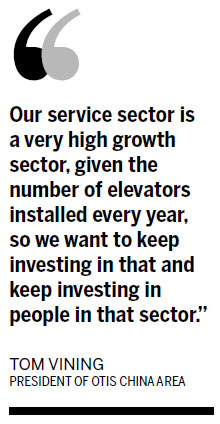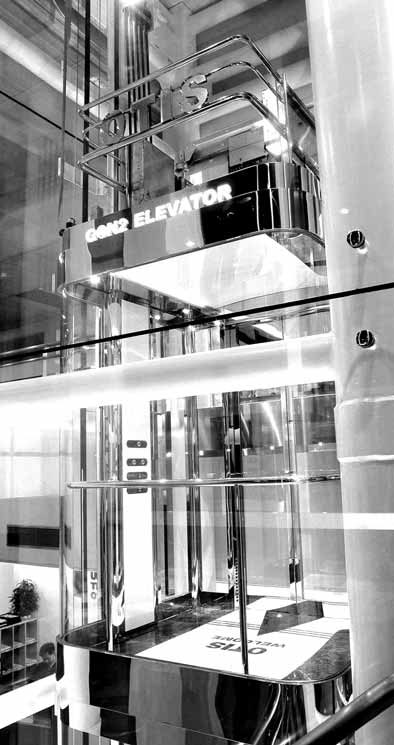Industry Special: Otis focuses on quality, safety to rebuild reputation in China
Updated: 2012-05-24 08:08
By Li Fangfang (China Daily)
|
||||||||
|
|

Safety has been the top priority in China's elevator and escalator industry in the wake of a number of escalator and elevator incidents over the past year, said one industry expert.
"Our priority right now is focusing on quality and safety and that's really my utmost priority and with my job right now and for always in China," said Tom Vining, president of Otis China Area, a unit of US-based United Technologies Corp.
Otis, the largest elevator provider in the world in terms of sales volume, saw its reputation marred by an escalator accident at a subway station in Beijing last year.
"We're very humbled by the experience last year. It's something we need to learn from, and we have learned from," Vining said.
"After the Beijing accident, we've really looked introspectively at what could we do better in our organization through the whole process - from manufacturing to installation and services".
He told China Daily that Otis will renew its focus on the foundation of its business called the "Three Absolutes": safety, ethics and financial controls.
"Safety means the safety of the riding public and for our employees. Ethics meaning doing business right with our customers and partners, and following the policies and laws. Financial controls means that we account for ourselves well," said Vining. "We call them the absolutes because it's an absolute expectation of everybody in the company to follow those three things first."
Zhang Lexiang, deputy secretary-general of the China Elevator Association, also said that the Beijing incident "is an important lesson for all the players".
"The Beijing escalator incident made a great impact on our industry. The major players checked the existing installations critical to safety to prevent the recurrence of the accidents," Zhang said. "The Beijing incident prompted a lot of reflection since Otis is the world's No 1 elevator company, with state-of-the-art technology and products, and it has always considered safety to be the core of business development."
To make sure safety is paramount in its fastest-growing market, Otis in late February appointed Vining president of its restructured operation in China, which now is a standalone subsidiary that reports directly to the global president. He has 23 years of experience doing field operations for the company and is also an expert in quality control and safety.
"It's really a commitment from the organization that we want to streamline our organization here. It's very important to our future growth," said Vining. "China has been our top important market as one out of every two elevators we sold in the world went to China, where we have installed approximately 400,000 Otis elevators in the 2-million-unit market."
Zhang said China is the world largest elevator manufacturer and consumer, with annual sales totaling 95 billion yuan ($15.1 billion). There were 406,000 elevators and 51,000 escalators manufactured on the Chinese mainland in 2011, which respectively accounted for 70 percent and 95 percent of the global new equipment installations of the year, with the combined year-on-year growth rate of 25.2 percent.
Moreover, there were nearly 31,000 passenger elevators and more than 16,800 escalators exported to more than 140 countries and regions, according to China Customs statistics, which means China is the world's largest elevator exporter. "By the end of 2011, the existing installations were more than 2 million units," Zhang said.
"For sure, the elevator industry in China will have a bright future, but the development rate in the next five years will vary to some extent because the market demand depends on the real-estate and transportation infrastructure construction, which are heavily influenced by government policy," he said.
"Although China has the largest existing installations, the per capita installation is still under the world average. Compared with the current situation of South Korea, which has an average of one elevator for every 120 people, the number of existing installations in China can probably reach 10 million in the next 20 years, which will provide great potential for our industry's development," Zhang said.
Vining also said he believes China's elevator industry will keep the momentum in the next years, as the real-estate and public transportation facility construction as well as urbanization will fuel a lasting growth for the industry for 15 to 20 years.
"China is only 50 percent urbanized at this point, with the continued urbanization rate of 1 percent and 20 million people per year, the elevator market will continue to grow," said Vining. "In addition, we can also foresee a growing market in the modernization of buildings at the stage when the real-estate owners and developers start modernizing all of those old elevators that have been installed over the last years."
"In five years, the replacement or modernization market will increase by a substantial amount. By then, our industry will be gradually getting on the track of sustainable development, with both the replacement and new equipment market as well as ever-growing maintenance business," Zhang said.
Vining agreed with Zhang, saying that "there's a high demand for quality and safety, and as the elevators that have been installed in the last 10 to 20 years get older, there are more and more requests to deploy (maintenance personnel), so the service market's going to continue growing."
"As the largest elevator market, China is surely also the biggest service market in the world. So it's an opportunity for us in this sector. Our service sector is a very high growth sector, given the number of elevators installed every year, so we want to keep investing in that and keep investing in people in that sector," said Vining.
More importantly, "as we look at the incidents, some of those incidents are on Otis elevators that we don't maintain, so I'm really pushing my people to get those elevators back into our service network because I have confidence in our service system and the quality of safety we can provide," said Vining.
Now Otis has set up one service department at each city where it operates, and they are specifically dedicated to servicing Otis elevators.
Vining told China Daily that in the coming years, service business will be the US company's focus with more investment to expand its headcount and increase the training.
"On a global basis, about two-thirds of our front-line field workforce are dedicated to service, maintenance and repair. For the China market, we have up to 50 percent of our entire workforce involved in maintenance, which is higher than the global average and to be continuously increased in the future because there's such a huge service market in China," said Vining.
Professional maintenance is critical to the safe operation of the elevator equipment. The estimated maintenance market of China in 2011 is 6 billion yuan and will grow steadily along with the increasing number of existing installations, Zhang said.
"The original equipment suppliers can normally provide the best services but at a higher price. Third party maintenance can be an option for those price-sensitive customers and can help the maintenance market prices form base on fair competition, not on monopoly," he added.
"Currently, the cut-throat price competition in the maintenance market is no good for the customers and players since some of the maintenance business is done with disregard for quality and safety. We have appealed to the government to do something to rein in this trend."
lifangfang@chinadaily.com.cn

 Relief reaches isolated village
Relief reaches isolated village
 Rainfall poses new threats to quake-hit region
Rainfall poses new threats to quake-hit region
 Funerals begin for Boston bombing victims
Funerals begin for Boston bombing victims
 Quake takeaway from China's Air Force
Quake takeaway from China's Air Force
 Obama celebrates young inventors at science fair
Obama celebrates young inventors at science fair
 Earth Day marked around the world
Earth Day marked around the world
 Volunteer team helping students find sense of normalcy
Volunteer team helping students find sense of normalcy
 Ethnic groups quick to join rescue efforts
Ethnic groups quick to join rescue efforts
Most Viewed
Editor's Picks

|

|

|

|

|

|
Today's Top News
Health new priority for quake zone
Xi meets US top military officer
Japan's boats driven out of Diaoyu
China mulls online shopping legislation
Bird flu death toll rises to 22
Putin appoints new ambassador to China
Japanese ships blocked from Diaoyu Islands
Inspired by Guan, more Chinese pick up golf
US Weekly

|

|







